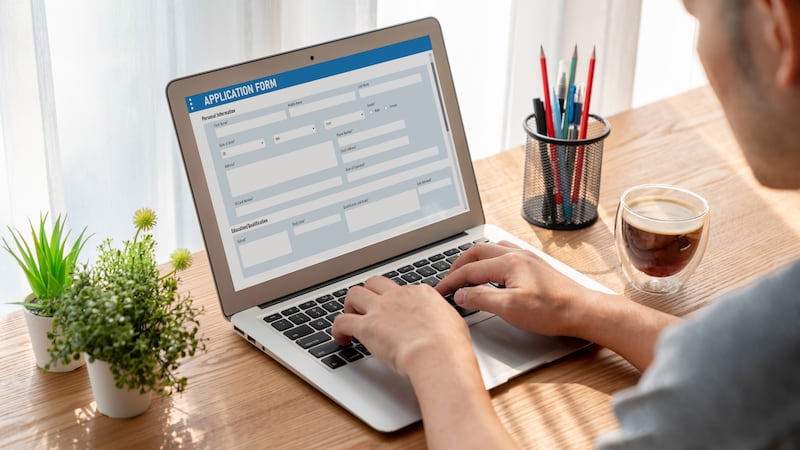Walk down any street and almost everyone will have a phone in their hand, scrolling on social media, sending likes or commenting underneath posts. Given its ubiquity, it is no wonder social media is now an integral part of building a career in many industries. But how can someone use it as a tool to advance their career?
Well, it’s quite simple, according to Paul Mullan, a career coach with Measurability. LinkedIn is perhaps the most widely recognised professional networking social media sites; it allows employees or those seeking employment to connect with prospective employers or recruitment firms. As a result, it is incredibly important for those seeking to either enter or progress in the world of work.
Firstly with LinkedIn, a picture or head shot is critical, Mr Mullan says: “The issue there is – certainly for people coming across your profile – if there’s no picture it looks like it’s inactive or perhaps not in use.”
Some people believe it is important to have a professional headshot taken for social media accounts but in many cases phone-camera quality is sufficient; it can depend on the sector you’re working in or hoping to work in, according to Mr Mullan.
RM Block
“Most people will have a professional head shot,” he says. “But people can get creative with that, as long as it is fitting for the role and the area that they’re working in.”
So, for example, if an individual is working in the film industry, an image of them working with a film camera would be an appropriate option. For those who work in baking, a shot of them working with their hands would also get that professionalism across.
But once you have your LinkedIn account activated and your photo in place, what then? This is where the “about me” section does a lot of work, says Mr Mullan. It offers people a sense of who you are and what you have to offer.
“Your professional headline is the first thing that people read. So think about how you can use that effectively to drive and draw people into your profile,” he says.
[ LinkedIn’s makeover lacks one thing: humourOpens in new window ]
“It’s probably more important than your work experience, because people are spending a very short space of time reading this stuff. Your LinkedIn profile should be succinct in terms of wording and content.”
However, that doesn’t mean it has to be boring: “It’s called social media, so the word social is important. So in the ‘about’ section, try to inject a little bit of personality.”
But does one need to be on social media? Is it really as important as everyone says? Well, given the online nature of the modern world, it really is a significant disadvantage to not be putting yourself and your work out there online.
“Another way of looking at this is, is a website important to a business?” Mr Mullan asks, rhetorically. “Anyone setting up a business, the first thing they’re looking for is a website, online platform or portal to represent their product or their service.
“It’s no different for a job seeker. It’s no different for somebody looking to build their personal brand [somewhere] such as LinkedIn, or any social media platform that allows individuals to have an online presence.”
[ Entrepreneurship and self-employment open up a new world of workOpens in new window ]
Many recruiters admit they will review the social-media accounts of job candidates before the interview stage or before they make a decision. Therefore, having that professional profile available to them makes it easier to show off you accolades and qualifications.
Before any interview, you should think about what your social-media profile says about you, Mr Mullan says. This is particularly important for careers such as marketing, where social media plays a key role; it is important to get across in your own social-media presence that you recognise its centrality to your chosen profession.
Back when all jobs were applied for with pen and paper, references were important. Nowadays they are still important but can be much easier to access, particularly on LinkedIn.
“When you’re creating your profile, recommendations or testimonials are important as well,” Mr Mullan says. “What you say about yourself is critically important but what others say about you probably carries more weight. So in LinkedIn you have that opportunity to get people to give you testimonials. They can endorse your skills.”
However, it is important to note the importance of engagement when it comes to building a social-media profile; whether you are posting your own content or engaging with others, it all goes a long way towards raising recognition of your “brand”.
“Engagement is critical. If you’re not active, you’re not visible,” says Mr Mullan. “And the more active you become, the more eyes you are bringing to your profile. Your activity draws those people into your profile; the more people that come to your profile, the better for you.”
Two out of three jobs are never advertised, Mr Mullan says. As such, ensuring you are in the minds of recruiters helps to ensure that “those hidden employment opportunities find you”.
When it comes to the question of what people should be posting on their professional profile professionalism is key; although it is acceptable to display some elements of your personality, you are looking to make employment contacts, not friends.
Mr Mullan’s advice is to “keep it simple” as many people can be “a bit nervous about what they post”.
“What I find is a lot of people are uncomfortable sharing. I would normally say ‘Get uncomfortable’, or ‘Get comfortable feeling uncomfortable.’
“But also you can follow, like, comment or engage with companies you want to work for and high influencers or people within your profession, and it’s a great way to showcase your expertise.”
Another easy way to create content is to share articles in the areas in which you’re interested in working. But be careful about what you’re posting: sharing pictures of you out partying may not be something a prospective employer wants to see. Also, be cautious around making negative comments about colleagues or companies online; once something is posted it is almost impossible to definitively remove it.
Overall, Mr Mullan says building a social-media presence is now a part of working life.
“Social media should be for life – it’s not just for when you’re on a job hunt; it’s about turning up every week,” he says. “Most people think about networking – whether real world or online on social media – when they need something. And you should be online; you should be engaging; you should be sharing.”
But you should also be helping people, he adds. If individuals you’re connected with are sharing questions and you have the answers, tell them. Not only is that good for the relationship between you and that individual, it’s also a great way to show recruiters that you’re a team player, that you’re a problem solver and are happy to help out.
Social media, and LinkedIn in particular, is akin to an ongoing interview, where you have the potential to impress prospective employers on any given day just by showing them what you’ve done or what you’re capable of.
“Someone said to me once, if you build an online profile visibility as well as your real-world visibility, you’ll never look for a job again,” says Mr Mullan.
When it comes to social media and your employability, remember:
- Have a social media account. This is the first step, but if you’re not putting yourself out there on the mediums recruiters and employers are using, how will they learn of your potential?
- Post. It’s not sufficient just to have an account. Engaging and posting and sharing thoughts and insights are the ways in which you appear on people’s timelines and become a recognisable name.
- Be professional. Though many of us use our Instagram accounts to share the parties, festivals and concerts we attend, if you are using that as a medium to seek employment you should be mindful of that fact. Ask yourself: Is this something I would want my boss to know?
- Be consistent. Think of social media as a facet of modern employment. Work it into your routine; it doesn’t have to take over everything but check in and use it regularly.
- Network. Don’t be afraid to connect with people online or ask them questions. Taking those online networking relationships into the real world as well is an excellent way to increase your employment opportunities.
- Sign up for push alerts and have the best news, analysis and comment delivered directly to your phone
- Join The Irish Times on WhatsApp and stay up to date
- Listen to our Inside Politics podcast for the best political chat and analysis



















